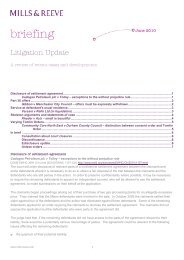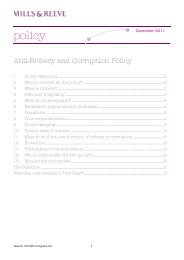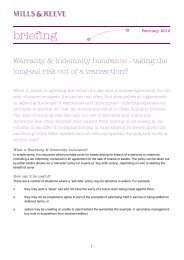Public Eye - Spring 2008 - Mills & Reeve
Public Eye - Spring 2008 - Mills & Reeve
Public Eye - Spring 2008 - Mills & Reeve
Create successful ePaper yourself
Turn your PDF publications into a flip-book with our unique Google optimized e-Paper software.
<strong>Public</strong>eye<br />
<strong>Spring</strong> <strong>2008</strong><br />
Full steam ahead:<br />
local handling of complaints about members<br />
A work in progress:<br />
the community infrastructure levy<br />
Pain relief:<br />
insolvency in the construction industry<br />
Equal pay:<br />
recent developments in the public sector<br />
A future prospect?<br />
Local asset backed vehicles<br />
Case law update<br />
In brief<br />
www.mills-reeve.com
Welcome to the spring edition of <strong>Public</strong> <strong>Eye</strong>, our local<br />
authority newsletter. With Christmas firmly out of the<br />
way, we look forward to a year of interesting<br />
developments for local authorities.<br />
In this issue, we examine the Government’s new<br />
take on the planning gain supplement (PGS) – the<br />
community infrastructure levy – and consider whether<br />
it is just another guise for the PGS. Regeneration<br />
projects could benefit from rosier finances if local asset<br />
backed vehicles (LABVs) are successfully introduced<br />
into the local government sphere – we explore the<br />
background of LABVs and what they could mean in<br />
the future.<br />
Insolvency in the construction industry is a major<br />
headache for local authorities and we look at some<br />
pragmatic ways to overcome, or at least reduce, the<br />
risk of contractors’ insolvency hitting your construction<br />
projects hard. We also review the dramatic changes<br />
arising out of the Local Government and <strong>Public</strong><br />
Involvement in Heath Act 2007 for councillor<br />
misconduct investigations. Finally, some recent equal<br />
pay cases relating to pay protection and back pay are<br />
given close scrutiny.<br />
Contents:<br />
3 Full steam ahead: local<br />
handling of complaints<br />
about members<br />
The Local Government and<br />
<strong>Public</strong> Involvement in Health<br />
Act 2007 is bringing about<br />
changes to how complaints<br />
about members are handled.<br />
4 A work in progress: the<br />
community infrastructure levy<br />
The planning gain supplement is<br />
dead – long live the community<br />
infrastructure levy?<br />
Nathan Holden<br />
Partner and Head of Local Authorities<br />
Tel: 0121 456 8350<br />
E-mail: nathan.holden@mills-reeve.com<br />
We welcome feedback on our publications and<br />
therefore, should you have any comments, please<br />
feel free to contact me.<br />
5 Pain relief: insolvency in the<br />
construction industry<br />
How local authorities can<br />
prevent or limit the damage<br />
when insolvency hits their<br />
construction partners.<br />
6 Equal pay: recent<br />
developments in the<br />
public sector<br />
Two new cases have cropped<br />
up to bring more complexity<br />
to equal pay.<br />
8 A future prospect?<br />
Local asset backed vehicles<br />
The Government is looking<br />
to promote new ways of<br />
managing local authorities'<br />
assets to fund regeneration.<br />
10 Case law update<br />
11 In brief<br />
12 Deals and news<br />
2
Full steam ahead:<br />
local handling of complaints<br />
about members<br />
From April <strong>2008</strong> the Local<br />
Government and <strong>Public</strong> Involvement<br />
in Health Act 2007 (the 2007 Act)<br />
will dramatically alter the course of<br />
how allegations into breaches of the<br />
Code of Conduct are handled. The<br />
new pair of safe hands will be in the<br />
form of the Local Standards<br />
Committee rather than the Standards<br />
Board for England.<br />
• There will be a new devolved<br />
regime for the handling of<br />
complaints against members<br />
• The deadline for<br />
implementation is 1 April<br />
<strong>2008</strong><br />
• All complaints will be the<br />
primary responsibility of the<br />
Local Standards Committee<br />
• Local authorities and their<br />
monitoring officers will need<br />
to start preparing now<br />
• New regulations will be<br />
forthcoming in due course<br />
Johann Wylly 0121 456 8226<br />
johann.wylly@mills-reeve.com<br />
Previously, all complaints were dealt with by<br />
the Standards Board, which was originally<br />
established in 2001, but focus will now shift<br />
to its role as regulator, rather than<br />
investigator. This role extends the board’s<br />
function of providing expert guidance to<br />
local authorities on the Code of Conduct,<br />
via publication of the Code of Conduct:<br />
Guide for Members and the Pocket Guide<br />
to the Code of Conduct. The following<br />
amendments will mean that, from April<br />
<strong>2008</strong>, the 2007 Act inserts a new section<br />
57A into the Local Government Act 2000<br />
substituting it for section 58.<br />
The new standards devolutionary regime<br />
has been fully supported by the Local<br />
Government Association, which has stated<br />
that such matters are best dealt with at a<br />
local level. The Local Standards Committee<br />
will make an initial assessment of<br />
misconduct allegations. Once it receives a<br />
complaint, it has three options as follows:<br />
• refer it to the monitoring officer who<br />
will subsequently investigate it;<br />
• refer it to the Standards Board; or<br />
• make a decision not to take any action<br />
at all.<br />
However, any reference to the Standards<br />
Board will only be on exceptional grounds,<br />
such as in the case of conflict issues or<br />
very serious allegations. It will be for the<br />
monitoring officer to shoulder the<br />
responsibility of investigation in<br />
most circumstances.<br />
What should monitoring officers be<br />
aware of?<br />
This new procedure amplifies monitoring<br />
officers’ responsibilities. 57B of the 2000<br />
Act has created a right for a complainant<br />
to make a written request for a review of<br />
a decision by the Standards Committee to<br />
take no action in respect of an allegation.<br />
The clock starts ticking once a request is<br />
received so that the Standards Committee<br />
is convened, an assessment is made and a<br />
decision regarding the allegation taken<br />
within three months.<br />
The Standards Committee must be properly<br />
constituted to uphold the rules of natural<br />
justice, so that the investigating members<br />
are not identical to the decision-making<br />
members. There should be at least two<br />
sub-committees, one for the assessment<br />
stage and one for the review decision. It<br />
does not mean that a member involved in<br />
either of the initial stages should not be<br />
involved in the conduct decision later on.<br />
The Standards Board has produced a<br />
Checklist for local authorities in the run<br />
up to April <strong>2008</strong> on their website. The<br />
constitution of Standards Committees is<br />
going to be a major consideration for local<br />
authorities, necessitating planning ahead<br />
and pooling members. Monitoring officers<br />
should consider:<br />
• ensuring that the local authority clears<br />
outstanding investigations before<br />
1 April <strong>2008</strong>;<br />
• establishing the arrangements for<br />
delegating assessment and review to<br />
sub-committees;<br />
• training members and equipping them<br />
for their new roles;<br />
• recruiting independent members; and<br />
• joint working, if appropriate, with<br />
neighbouring local authorities.<br />
The Department for Communities and Local<br />
Government has released a consultation<br />
document on the detailed arrangements for<br />
putting into effect orders and regulations,<br />
and the closing date for responses was 15<br />
February <strong>2008</strong>. There will therefore only be<br />
a short timeframe between release of<br />
regulations and the deadline of 1 April<br />
<strong>2008</strong>. Local authorities must not get<br />
shipwrecked by the new processes<br />
otherwise they may be subject to the<br />
Standards Board’s powers of intervention<br />
if their functions are not discharged<br />
satisfactorily. However, having an expert<br />
navigator, namely, the monitoring officer,<br />
to steer the local course will reap vital<br />
benefits in promoting local trust in the<br />
new ethical regime.<br />
3
A work in progress:<br />
the community<br />
infrastructure levy<br />
David Brock 01223 222438<br />
david.brock@mills-reeve.com<br />
Oliver Bussell 01223 222542<br />
oliver.bussell@mills-reeve.com<br />
The proposals for the community<br />
infrastructure levy (CIL) were made shortly<br />
after the demise of the planning gain<br />
supplement (PGS) last October. More is<br />
becoming known now, as CIL emerges as<br />
a part of the Planning Bill.<br />
What are they trying to do?<br />
The Government’s justification for seeking<br />
CIL is the shortage of national, regional and<br />
local infrastructure. The Bill requires<br />
regulations to be made for CIL and sets<br />
out heads of terms for their operation.<br />
Any authority with responsibility for<br />
planning may charge CIL. The regulations<br />
must specify the process for calculation and<br />
collection, the uses to which CIL can be<br />
applied and enforcement. Authorities must<br />
use CIL to fund infrastructure, they may be<br />
required to refund overpayments and may<br />
be allowed to accept payment in kind.<br />
How will CIL work?<br />
Charging authorities must prepare lists of<br />
projects and set rates for CIL. It is not clear<br />
where this will occur. Local planning<br />
authorities can use the local development<br />
framework process. But what will be used<br />
by the other charging authorities? If the<br />
information is contained in development<br />
plan documents, they will be subject to<br />
examination and correction by the Planning<br />
Inspectorate. But if within supplementary<br />
planning documents (as appears possible)<br />
scrutiny could be much less rigorous.<br />
Then some sort of rate needs to be set.<br />
CIL will be payable on commencement of<br />
development with liability attaching to the<br />
owner of land at the date of commencement.<br />
The Bill also contemplates payment by<br />
instalments. CIL will be payable whether or<br />
not the value of a piece of land has increased<br />
following a grant of planning permission.<br />
The amount of CIL will be determined<br />
by reference to the date of the planning<br />
permission as a result of which CIL<br />
becomes payable.<br />
CIL can also be calculated by reference to<br />
increases in value consequent on a grant of<br />
permission. This is leading many to ask, “is<br />
this PGS by another name?”.<br />
Legal and funding issues<br />
Non-payment or late payment of CIL may<br />
mean that a planning permission is either<br />
suspended or cancelled. Such revocation<br />
currently gives an entitlement to<br />
compensation. Allowing permissions to be<br />
suspended or cancelled could cause funding<br />
problems. Those carrying out due diligence<br />
on transactions will need to see a CIL<br />
“receipt” – proof against new enforcement<br />
measures being taken.<br />
Another issue is that liability for payment<br />
attaches to an owner of land at the time<br />
when CIL becomes payable. This works<br />
where a landowner obtains permission for<br />
development of his land. But one can apply<br />
for permission over a third party’s land.<br />
What happens at a large development<br />
covering the land of several owners?<br />
Not all of them will even welcome the<br />
development, yet they may be liable for CIL.<br />
While the regulations must require the<br />
collecting authority to apply CIL to<br />
infrastructure, questions remain over<br />
monitoring and delivery. Developers will<br />
want the infrastructure to be delivered as,<br />
presumably, will the electorate. A Grampian<br />
condition preventing development until the<br />
infrastructure is delivered could cause<br />
double charging. Monitoring may be<br />
expensive but it will be necessary.<br />
The Bill also allows section 106 and section<br />
278 agreements to be regulated. Why are<br />
section 38 agreements omitted? Given<br />
however that permissions can also be<br />
controlled and infrastructure effectively<br />
required through conditions it seems to<br />
us that there are other issues that need<br />
to be addressed.<br />
Conclusions<br />
Obviously there is some way to go on CIL.<br />
It is not going to be an easy levy to<br />
calculate and administer. Determining what<br />
infrastructure it covers and the cost will<br />
require manpower. The implications of<br />
linking a levy to implementation of a<br />
permission are considerable. Interrelationship<br />
with the planning system as a whole is<br />
complex. We look forward to the next stage<br />
with interest.<br />
• The community infrastructure<br />
levy is the replacement for the<br />
planning gain supplement<br />
• There is currently a lack of<br />
clarity on rates to be set<br />
• Linked to planning permissions<br />
– non-payment could lead to<br />
suspension or cancellation<br />
of permissions<br />
• Liability for payment attaches<br />
to the landowner at the time<br />
the CIL is payable<br />
• There are concerns regarding<br />
the interrelationship with the<br />
overall planning system<br />
4
• Insolvency can have serious<br />
consequences for local<br />
authorities<br />
• Termination of the building<br />
contract is often an option<br />
• Consider the mechanics of<br />
payment and the provisions of<br />
the Housing Grants,<br />
Construction and Regeneration<br />
Act 1996<br />
• Proper checks prior to entering<br />
into contracts can mean<br />
greater protection<br />
• Local authorities need to be<br />
proactive to protect against<br />
insolvency<br />
Pain relief: insolvency in the<br />
construction industry<br />
Many local authorities are involved in large<br />
and expensive projects. It is often the case<br />
that costs and timetables for projects will be<br />
tight. Therefore any problems that arise on<br />
site or with the contractor will have serious<br />
consequences for the local authority and its<br />
ability to complete the project on time and<br />
on budget.<br />
One of the worst headaches a local authority<br />
can face during a project is the main building<br />
contractor becoming insolvent during the<br />
course of a construction project.<br />
The local authority will need to be aware of<br />
the disruption that is likely to be caused by<br />
an insolvent contractor:<br />
• The works are likely to be delayed and<br />
costs are likely to escalate while a new<br />
contractor is sourced.<br />
• Any defects in the work carried out by the<br />
contractor are likely to need to be put right<br />
at the local authority’s expense, unless<br />
suitable insurance is in place.<br />
• In some circumstances, a local authority<br />
can also find itself liable for unpaid<br />
sub-contractors’ fees, despite having paid<br />
the contractor for that work already, in<br />
effect paying twice for the same work.<br />
Any direct relationships between a local<br />
authority and the sub-contractors need to<br />
be carefully managed and kept at an arm’s<br />
length or, if possible, avoided completely to<br />
avert this situation.<br />
• Issues can also arise over ownership of<br />
materials on site.<br />
Local authorities might think that the only<br />
option would be to become an unsecured<br />
creditor and join the queue of those in a<br />
similar position with no realistic prospect of<br />
recovering any or even very little money.<br />
What, if anything, can the local authority do<br />
to gain relief from the pain of insolvency?<br />
First, it should be noted that, under most<br />
building contracts, insolvency is often a<br />
trigger allowing the employer to terminate<br />
the building contract.<br />
Second, it may also have an effect on the<br />
mechanics of payment. Under section 111<br />
of the Housing Grants, Construction and<br />
Regeneration Act 1996, a party to a<br />
construction contract may not withhold<br />
payment that would otherwise fall due<br />
for payment unless it has given what is<br />
known as a withholding notice within<br />
the required timeframe.<br />
The recent case of Melville Dundas Ltd (in<br />
receivership) v George Wimpey UK Ltd<br />
(2007) looked at this principle. It decided that<br />
there was an exception to it. The exception<br />
was where there was a contractual<br />
entitlement not to have to make certain<br />
payments. This case was dealing with a<br />
provision in the 1998 JCT with Contractor’s<br />
Design Form of Contract, which enables an<br />
employer under a building contract (such as<br />
an NHS trust) to determine the contract<br />
where a contractor becomes insolvent. The<br />
JCT form provides that the employer does<br />
not have to make payments that are due to<br />
the contractor if they fall due less than 28<br />
days before the employer first had the right<br />
to determine the contract. In this case the<br />
court held that the employer did not have to<br />
make payment even though no withholding<br />
notice had been served.<br />
There are also steps that can be taken before<br />
any contract with the contractor is entered<br />
into, which will help to protect local<br />
authorities as the employer, if the contract<br />
later becomes insolvent. It is often a<br />
straightforward process to ascertain the<br />
financial standing of a main contractor prior<br />
to contracting with them. For example,<br />
obtain three years’ worth of the contractor’s<br />
accounts and obtain a credit rating for the<br />
contractor. Finally, the local authority’s<br />
protection can also be improved by contract<br />
amendments to the standard forms, the<br />
holding of retention at an appropriate level<br />
and by ensuring the contractor gives<br />
appropriate guarantees, bonds and<br />
insurance.<br />
Ruth Phillips<br />
0121 456 8211<br />
ruth.phillips@mills-reeve.com<br />
5
Equal pay: recent<br />
developments in<br />
the public sector<br />
Charles Pigott 01223 222411<br />
charles.pigott@mills-reeve.com<br />
Overview<br />
Over the past year we have begun to see<br />
cases emerging that reflect the enormous<br />
complexity of the equal pay issues<br />
generated by Agenda for Change in the<br />
NHS and the Single Status Agreement in<br />
the local authority sector. The cases we<br />
refer to below have been brought in the<br />
local authority sector in the North East, but<br />
the legal principles can readily be translated<br />
to the public sector as a whole.<br />
Pay protection<br />
Pay protection (or “red circling”) is often<br />
used by employers to protect certain<br />
groups of workers from the immediate<br />
reduction in pay they would otherwise<br />
have faced as a result of the<br />
implementation of a job evaluation scheme<br />
(JES). Given that this can result in workers<br />
in traditionally female jobs (like catering or<br />
cleaning) continuing to receive less pay<br />
than their male comparators during the pay<br />
protection period, is this in itself a breach<br />
of the Equal Pay Act?<br />
The Employment Appeal Tribunal (EAT) has<br />
come to two different decisions on this<br />
point, in cases which had very similar facts.<br />
Both cases involved a group of female<br />
workers in the North East who were able<br />
to establish equal pay claims up to the<br />
point the council’s JES had been<br />
implemented. However, because of pay<br />
protection, they continued to be worse off<br />
than their male comparators even after the<br />
implementation date. They argued that<br />
they should also receive the same level<br />
of “pay protection” as their male<br />
counterparts.<br />
In the first decision (Bainbridge (No 1) v<br />
Cleveland Borough Council) the EAT ruled<br />
that the council’s pay protection scheme<br />
could not be justified, and therefore the<br />
claimants’ pay should be raised to the level<br />
of the protected pay of their male<br />
comparators. In the second decision,<br />
announced eight months later<br />
(Middlesbrough Council v Surtees), the EAT<br />
reached the opposite conclusion. The only<br />
difference between the two cases was that<br />
in Bainbridge the council had already<br />
conceded some of the equal pay claims,<br />
whereas in Surtees this had not happened.<br />
Both appeals have now been heard by the<br />
Court of Appeal, but at the time of writing<br />
it has not announced its decision.<br />
Does a JES have retrospective effect?<br />
Ms Bainbridge and her cohort of litigants<br />
have not been idle. Not content with their<br />
victory in their first outing, they went to<br />
the EAT a second time. This time the issue<br />
was whether the job evaluation scheme<br />
introduced by Cleveland Council in April<br />
2004 had retrospective effect. In other<br />
words, did the fact that the JES had rated<br />
their work as equivalent to that done by<br />
their male comparators with effect from<br />
April 2004 entitle them to back-date their<br />
equal pay claims to earlier periods when<br />
both they and their comparators were<br />
doing comparable jobs?<br />
In a decision announced earlier this<br />
year the EAT ruled that a JES was not<br />
retrospective in this sense. While the<br />
claimants may well have had valid equal<br />
pay claims for earlier periods, the JES was<br />
not an automatic passport to success. They<br />
would have to prove their claims – which<br />
would have to be for like work or work of<br />
equal value – in the usual way.<br />
Back pay<br />
While the second Bainbridge decision is<br />
obviously helpful to employers introducing<br />
a JES, it does not necessarily mean that<br />
employees will not be able to bring<br />
back-dated claims in respect of the period<br />
prior to its implementation. The difficulties<br />
that public sector employers currently face<br />
in relation to back pay is graphically<br />
illustrated by the EAT’s recent decision<br />
involving the GMB.<br />
GMB v Allen involves a number of women<br />
employed by Middlesbrough Council who<br />
considered that they had been let down<br />
by the way the GMB had negotiated their<br />
claims for back pay under the Equal Pay<br />
Act. Their argument was that the union<br />
had pushed for pay protection for the<br />
members who stood to lose pay as a result<br />
of the council’s JES (who were<br />
predominantly male) at the expense of<br />
the claims for back pay brought by their<br />
6
female members with equal pay claims.<br />
As a result, these claims were settled for<br />
significantly below their true value –<br />
for as little as 25 per cent of what the<br />
council thought they were worth.<br />
The women successfully argued that they<br />
had been subjected to what, in the<br />
absence of justification, would have been<br />
indirect sex discrimination by the GMB.<br />
However, the GMB convinced the EAT that<br />
the way the women had been treated was<br />
justified, in the sense that it was a<br />
proportionate means of achieving<br />
a legitimate aim, ie, to protect its members<br />
against a cut in pay and to safeguard jobs.<br />
The EAT decision may have given the<br />
unions a breathing space, but their cause<br />
will not have been helped by remarks<br />
made in the course of the judgment. The<br />
EAT said that it was possible that the GMB<br />
had acted negligently or misled the<br />
women but added that, whether this was<br />
the case or not, it did not affect its<br />
decision that the GMB had not been guilty<br />
of sex discrimination. It is not clear<br />
whether the launch of negligence claims<br />
against a number of public sector unions –<br />
as many as 3,000 of them according<br />
to recent reports – is connected with<br />
these remarks.<br />
The future<br />
The cases we have mentioned here throw<br />
up a number of other equal pay issues.<br />
There is no space to go into these, but it is<br />
apparent just from the points we have<br />
been able to cover that public sector<br />
employers face a rocky road ahead, even if<br />
the appeals currently in the pipeline go<br />
their way.<br />
7
A future prospect?<br />
Local asset backed<br />
vehicles<br />
Louise Whitehouse 0121 456 8304 louise.whitehouse@mills-reeve.com<br />
8
Local authorities are currently sitting on billions of pounds worth of saleable property assets,<br />
prompting the Government to look into this issue, knowing active management of these assets<br />
would create more opportunities for local government.<br />
Funds could be generated that would<br />
reduce councils’ financial dependence<br />
on central government, and property<br />
investors would realise the potential profit<br />
from buildings and sites that have not<br />
previously been available to them.<br />
Newly-acquired finances could be<br />
recycled to provide long-term funding<br />
for much-needed regeneration projects.<br />
Selling property assets to bring in receipts<br />
is nothing new, however now the<br />
Government is encouraging retention of<br />
assets and the forming of partnerships<br />
with the private sector in property<br />
development joint ventures called local<br />
asset backed vehicles (LABVs). The idea<br />
behind such ventures is that the council<br />
places some of its property assets into the<br />
vehicle and the private sector puts in<br />
money equivalent to their value. Councils’<br />
property portfolios could be developed<br />
this way to bring in more value from<br />
retaining their assets than from selling<br />
them off.<br />
Background<br />
The concept was first introduced in a<br />
government consultation last year on the<br />
proposed city development companies<br />
(CDCs). It considered the ways in which<br />
LABVs and CDCs could interrelate. CDCs<br />
are based upon the concept of urban<br />
regeneration companies, although it has<br />
been suggested that these companies be<br />
created on a much larger scale. They will<br />
have an increased geographical coverage,<br />
a broader range of functions, an<br />
increased profile and leverage over<br />
greater budgets. Consequently, their aim<br />
is to push forward regeneration projects<br />
across cities. One conclusion was that the<br />
companies themselves should be local<br />
asset backed vehicles as these vehicles are<br />
also able to hold assets, a feature that is<br />
lacking in CDCs.<br />
Clearly it would be advantageous for all<br />
of the players involved in regeneration<br />
projects to be under one roof. It is more<br />
efficient to combine the public and<br />
private sector in vehicles such as these<br />
LABVs. By acting as a corporate vehicle,<br />
it places such regeneration work at the<br />
heart of the market, attracting investors.<br />
How do these vehicles work<br />
in practice?<br />
These LABVs have been piloted, albeit<br />
not within the local authority sector, but<br />
by regional development agencies. One<br />
such agency, EMDA, has created the<br />
vehicle Blueprint, a partnership between<br />
English Partnerships, EMDA and Morley<br />
Fund Management’s Igloo Regeneration<br />
(as the private sector partner). This vehicle<br />
has been developed to stimulate and<br />
deliver sustainable development to assist<br />
the East Midlands to deliver their social<br />
and economic agendas. It is a device<br />
through which partners, urban<br />
regeneration companies and other public<br />
sector bodies can deliver their physical<br />
regeneration plans.<br />
The concept of CDCs, on the other<br />
hand, has been piloted within the local<br />
authority sector, an example being<br />
Creative Sheffield. This company<br />
combined the functions of the agencies<br />
Sheffield One, Sheffield First for<br />
Investment and Cultural Industries<br />
Quarter to form one single economic<br />
development company for the city. To<br />
combine all of these functions provides<br />
a single entry point for interested parties,<br />
therefore making the project that much<br />
more efficient and attractive to investors.<br />
A successful project has been the<br />
development of St Paul’s Place, providing<br />
business and leisure facilities in the heart<br />
of the city.<br />
Any concerns?<br />
One concern, which has been voiced by<br />
David Hughes (the regional director for<br />
North East, Yorkshire and East Midlands<br />
at the national regeneration agency,<br />
English Partnerships) is that the councils<br />
would be “putting all of the family silver<br />
in a single pot”. Some councillors may<br />
baulk at this concern as, should the<br />
vehicle invest in a few unfortunate<br />
property ventures, then this could<br />
have serious repercussions for the<br />
local authority.<br />
A factor that may be slowing down<br />
progress is the delay over the introduction<br />
of JESSICA, which is a new European<br />
Commission (EC) backed investment tool<br />
for urban areas. JESSICA allows European<br />
Union member states to invest a portion<br />
of their structural funding in urban<br />
regeneration projects, on which they<br />
will get a return. JESSICA-approved funds<br />
could be channelled through an LABV,<br />
however the Department for Communities<br />
and Local Government is still seeking<br />
more clarity from the EC about how<br />
JESSICA will work in practice, and has<br />
yet to implement the tool in England.<br />
Jonathan Bull-Diamond, a partner at King<br />
Sturge, has commented that “this vehicle<br />
can create a lot of value for both the<br />
council and the developer”. At present<br />
councils are a step behind the regional<br />
development agencies as they have not<br />
yet piloted these schemes, although this<br />
may well change in the near future.<br />
• Local asset backed vehicles<br />
(LABVs) are a new concept<br />
to fund regeneration<br />
projects<br />
• LABVs could interrelate with<br />
city development<br />
companies to hold assets<br />
• They have been piloted by<br />
regional development<br />
agencies while CDCs have<br />
been piloted within local<br />
authorities<br />
• There are some concerns<br />
that will have to be ironed<br />
out<br />
• LABVs could be very<br />
advantageous for local<br />
authorities and developers<br />
9
Case law update<br />
Johann Wylly 0121 456 8226<br />
johann.wylly@mills-reeve.com<br />
10<br />
Accent Peerless Limited v Kingsdon &<br />
Kingsdon (12 December 2007)<br />
This case involved two tenants against<br />
whom possession proceedings were brought<br />
under the Housing Act 1988 by a housing<br />
association. The association claimed that<br />
the defendants’ behaviour had amounted<br />
to a campaign of harassment against their<br />
neighbour.<br />
The tenants both suffered from<br />
post-traumatic stress disorder and, as a<br />
result, they were hypersensitive to noise and<br />
tended to exaggerate the effect on them of<br />
noise and other disturbances. They made<br />
repeated complaints about their neighbours<br />
to the Environmental Health Department, to<br />
the association and to the police. This,<br />
together with behaviour such as contacting<br />
their neighbour’s employer to make false<br />
allegations, led to this claim of harassment.<br />
At the trial, a psychiatrist gave evidence to<br />
the extent that the defendants could control<br />
their behaviour to a degree, but that their<br />
feelings about the current situation would<br />
not change without medical treatment and<br />
therefore, given that they had refused this<br />
treatment, they were unlikely to give up this<br />
campaign against their neighbours.<br />
The judge found that the defendants were<br />
guilty of the acts of nuisance and that their<br />
conduct was unjustified. He therefore<br />
granted an outright possession order. The<br />
defendants appealed this decision on the<br />
basis that their behaviour had now ceased<br />
and therefore it was not reasonable to make<br />
a possession order. The Court of Appeal<br />
dismissed this contending that, although<br />
there had been an improvement in the<br />
defendants’ behaviour, they had refused<br />
treatment. This clearly showed that their<br />
attitude had not changed and therefore, in<br />
light of their medical condition, it was likely<br />
that the defendants would re-offend.<br />
Letting International Ltd v Newham<br />
London Borough Council (21 December<br />
2007)<br />
The facts of this case were that the<br />
appellant property management company<br />
had brought proceedings alleging that the<br />
local authority had failed to disclose in<br />
advance the full criteria for awarding<br />
contracts, had therefore acted unfairly and<br />
without transparency and was in breach of<br />
the <strong>Public</strong> Contracts Regulations 2007. The<br />
company had applied for an interim<br />
injunction to prevent the authority from<br />
entering into further contracts until the<br />
conclusion of proceedings.<br />
The key issue was whether there was a<br />
serious issue to be tried about a tendering<br />
procedure adopted by the local authority<br />
and also whether an interim injunction<br />
should have been granted. The judge in the<br />
High Court found that, though the case was<br />
arguable, it was not sufficiently strong to<br />
warrant the grant of an injunction. Further,<br />
while damages would be a sufficient remedy<br />
for the company, they would not be<br />
adequate for the local authority and so the<br />
balance of convenience was against<br />
granting the junction.<br />
The Court of Appeal reminded itself of the<br />
test for granting of interim relief in American<br />
Cyanamid Co (No1) v Ethicon (1975):<br />
whether or not there was a serious issue to<br />
be tried, whether damages were an<br />
adequate remedy and whether the balance<br />
of convenience favoured maintaining the<br />
status quo. The local authority had argued<br />
that there was no serious issue to be tried<br />
because the company could not<br />
demonstrate that it had suffered any loss or<br />
risk of loss and it could not show that, but<br />
for the alleged breaches, the company<br />
would have been successful. The Court of<br />
Appeal said that this test set the bar too<br />
high. It was not required that every claim<br />
had to show that there would otherwise<br />
have been a successful tender. What the<br />
company had lost was the chance to<br />
compete and this was enough.<br />
The decision takes a logical principled<br />
approach and one which is within the spirit<br />
of competitive tendering. It illustrates that<br />
local authorities can face challenges<br />
notwithstanding that the challenger<br />
would probably not have been awarded<br />
the contract in any event and is a reminder<br />
to public bodies generally of the need to<br />
maintain scrupulous standards of<br />
transparency in tendering.<br />
Camden London Borough Council v<br />
Price Job (18 December 2007)<br />
Camden dismissed Mrs Price-Job nine<br />
months into a two-year term because of her<br />
disability-related sickness absence. The key<br />
issue in this case was whether the duty to<br />
make reasonable payment adjustments<br />
under the Disability Discrimination Act 1995<br />
was limited to steps that the employer knew<br />
or ought to have known were available.<br />
The employment tribunal had concluded<br />
that termination of her employment was not<br />
justified and that, if the local authority had<br />
complied with its duty to provide various<br />
items of workstation equipment, she would<br />
have been able to work. It found that the<br />
local authority was also under a duty to<br />
arrange its own medical assessment and<br />
that it ought to have allocated some of<br />
her duties to another person during her<br />
absence.<br />
The Employment Appeal Tribunal (EAT)<br />
allowed the appeal. It remitted the questions<br />
of adjustments and justification to the<br />
tribunal. It concluded that failure to obtain<br />
medical assessment before dismissal is not<br />
breach of duty to make reasonable<br />
adjustments. To conclude that the duty was<br />
dependent on the employer's knowledge<br />
would substantially restrict the nature of the<br />
duty and could not be derived from the<br />
statutory words. HHJ Burke said:<br />
"The duty is to make adjustments ... in order<br />
to prevent the effect of the substantial<br />
disadvantage which must be proved to exist<br />
... The steps contemplated by s.4A must<br />
have the effect of preventing, in whole or in<br />
part, that disadvantage; the obtaining of a<br />
medical assessment does not ordinarily have<br />
that effect. It may inform the employer of a<br />
step or steps which could fall within s.4A;<br />
but there is nothing in s.4A to suggest that<br />
the duty to make reasonable adjustments<br />
arises only when the employer knows or<br />
ought to have known that such a step or<br />
steps is or are available ... "
In brief<br />
Johann Wylly 0121 456 8226<br />
johann.wylly@mills-reeve.com<br />
Corporate manslaughter sentencing<br />
guidelines<br />
It has already been widely reported that the majority of<br />
the Corporate Manslaughter and Corporate Homicide<br />
Act 2007 will come into force on 6 April <strong>2008</strong>.<br />
The Sentencing Advisory Panel (SAP) has recently<br />
published a consultation paper on how the courts<br />
will calculate the fines to be imposed on organisations<br />
found guilty of the new offence of corporate<br />
manslaughter. This paper makes it clear that the fines for<br />
the new offence should be much higher than those<br />
currently ordered by the courts. They suggest that the<br />
starting point should be 5 per cent of the offender's<br />
average annual turnover but this will be adjusted to take<br />
account of the aggravating and mitigating features.<br />
The paper also looks at how the courts will calculate<br />
fines to be imposed on organisations found guilty of<br />
work-related deaths under existing health and safety<br />
legislation where the offence of corporate<br />
manslaughter is not made out. In those cases they<br />
suggest that the courts should take as a starting point<br />
2.5 per cent of the average annual turnover of the<br />
defendant organisation. The SAP expresses the hope<br />
that this will at least lead to a consistency of approach<br />
by the courts even if the actual levels of the fines<br />
themselves will still vary widely.<br />
Responses to this consultation paper were due on 7<br />
February <strong>2008</strong>, so it is questionable whether the final<br />
sentencing guidelines will be published before the Act<br />
comes into force. The paper is available to download<br />
from www.sentencing-guidelines.gov.uk/<br />
New compulsory purchase order inquiry<br />
procedure rules<br />
A Circular, together with the new Compulsory<br />
Purchase (Inquiries Procedure) Rules 2007 (SI<br />
2007/3617) that came into force on 29 January 2007,<br />
has been released giving guidance on the new rules.<br />
They take account of changes introduced by Part 8 of<br />
the Planning and Compulsory Purchase Act 2004 and<br />
the subsequent Compulsory Purchase of Land (Written<br />
Representations Procedure) (Ministers) Regulations<br />
2004 (SI 2004/2594). These changes are part of the<br />
Government’s commitment to unify the rules to<br />
comprise ministerial and non-ministerial CPOs. They<br />
also reflect current practices adopted in procedure rules<br />
for other types of inquiries. The rules are available from<br />
www.opsi.gov.uk/si/si2007/uksi_20073617_en_1 and<br />
the Circular is available at www.communities.gov.uk/<br />
documents/planningandbuilding/pdf/15. They should<br />
help to streamline the inquiry process.<br />
11
Deals<br />
Walsall MBC<br />
The local authorities team has recently won a tender to Walsall MBC to draft and negotiate an agreement for<br />
domiciliary care services worth £7 million per annum. This project is intended to deliver high quality services to the<br />
local area and to improve capacity and stability in the local market by utilising block purchasing methods.<br />
Coventry City Council<br />
A team, led by Guy Hinchley and assisted by Nathan Holden and Chris Plumley, has advised Coventry City Council on<br />
a £360 million housing regeneration programme. The project will see around 3,500 new homes being built in the<br />
northeast area of Coventry over the next 12 years, with work expected to start in 2009.<br />
The London Borough of Newham<br />
A team led by Nick Finlayson-Brown has advised longstanding client, the London Borough of Newham, on the<br />
acquisition of a landmark new-build on the Royal Albert Dock. The acquisition of 300,000 square feet will see the<br />
relocation of 2,000 key staff currently dispersed in over 24 buildings across the borough. The transaction drew on<br />
expertise from <strong>Mills</strong> & <strong>Reeve</strong>’s local government team (on governance matters) as well as the real estate, construction,<br />
employment and planning and environmental teams.<br />
Local government team news<br />
SLG Annual Weekend School<br />
As usual, we are hosting a stand and sponsoring this year's Weekend School on 3-6 April <strong>2008</strong> at Exeter University.<br />
We are looking forward to meeting old and new faces, both at our stand and at the annual dinner.<br />
New appointment<br />
Alex Jones has recently joined our real estate team in Birmingham as a partner from DLA Piper, where he advised<br />
clients including Coventry City Council on their participation in the Ricoh Arena project and Birmingham City Council<br />
on a number of key real estate-based schemes. Alex specialises in large-scale real estate transactions including town<br />
centre redevelopment projects.<br />
Seminars<br />
Our regular Local Authority Legal Update seminar is being held on 22 May <strong>2008</strong> at our Birmingham office. It<br />
will be covering a variety of topics relevant to local authorities. If you would like more information, or to book<br />
a place on this seminar, please contact Joy Middleton in our marketing team on 0121 456 8216 or e-mail<br />
joy.middleton@mills-reeve.com<br />
www.mills-reeve.com<br />
Telephone: 0844 561 0011<br />
BIRMINGHAM • CAMBRIDGE • LEEDS • LONDON • MANCHESTER • NORWICH<br />
<strong>Mills</strong> & <strong>Reeve</strong> LLP is a limited liability partnership regulated by the Solicitors Regulation Authority and registered in England and<br />
Wales with registered number OC326165. Its registered office is at Fountain House, 130 Fenchurch Street, London, EC3M 5DJ, which<br />
is the London office of <strong>Mills</strong> & <strong>Reeve</strong> LLP. A list of members may be inspected at any of the LLP’s offices. The term “partner” is used<br />
to refer to a member of <strong>Mills</strong> & <strong>Reeve</strong> LLP.<br />
<strong>Mills</strong> & <strong>Reeve</strong> LLP will process your personal data for its business and marketing activities fairly and lawfully in accordance with<br />
professional standards and the Data Protection Act 1998. If you do not wish to receive any marketing literature from <strong>Mills</strong> & <strong>Reeve</strong><br />
LLP please contact Katie Jelley on 0121 456 8380 or e-mail katie.jelley@mills-reeve.com<br />
The articles featured in this publication have been selected and prepared with a view to disseminating key information.<br />
Space dictates that any article may not deal with individual concerns but the author would be pleased to respond to specific<br />
queries. No liability can be accepted in relation to particular cases. Before taking action, you should seek specific legal advice.<br />
Copyright in this publication belongs to <strong>Mills</strong> & <strong>Reeve</strong> LLP. Extracts may be copied with our prior permission and provided that their<br />
source is acknowledged.<br />
March <strong>2008</strong>















